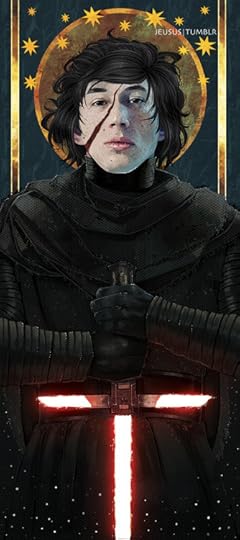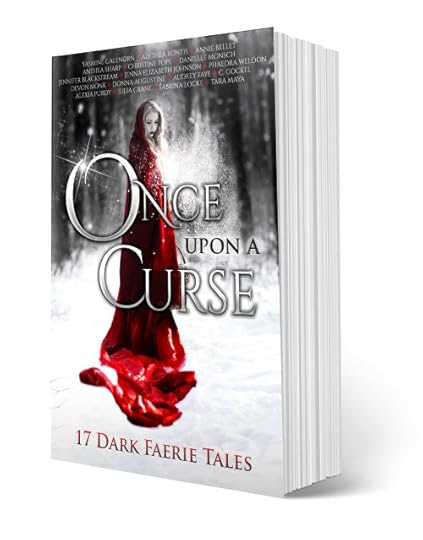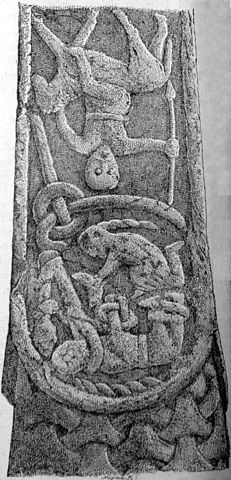C. Gockel's Blog, page 19
June 6, 2016
priscellie:
postmodernmulticoloredcloak:
yiffmaster:
this is...

this is my fav bc an actual major cause for the fall of rome was the resistance of the wealthy to paying taxes which led to a crumbling of infrastructure but who cares about thaaaaat
“Feminism killed Rome” is my new favorite sentence of all time.
Also ballooning military spending, a widening gap between rich and poor, religious intolerance following the Emperor’s embrace of Christianity, and lead poisoning of the water supply.
*looks at camera*
Huh. And all this time I was believin’ that it was the GAAAYYYYYSSS that killed Rome because I heard it once on Rush Limbaugh (don’t ask.) Maybe it was gays and feminism? (Gays and feminists doesn’t that make you feel powerful? Gay feminists doubly so!)
deathandmysticism:
Von Theodor Haufmann, Der Teufel und die...
"Until the lion learns how to write, every story will glorify the hunter."
- African Proverb (via wordsnquotes)
May 31, 2016
lokisergi:
boysquad:
Thor 2011 concept art by Ryan...
May 30, 2016
artursadlos:
Tinkerbell design for Peter Pan...

Tinkerbell design for Peter Pan musical
#picoftheday #artoftheday #instaart #artursadlos #instafollow #art #peterpan #fantasy #woman #sexy #fairy #wings #beauty #girl #magic #flying #classic #musical #conceptart #design #characterdesign #character #cgart
Mythic!
May 29, 2016
jeusus:
Dreamers
They never learn
They never learn
Beyond the...

Dreamers
They never learn
They never learn
Beyond the point
Of no return
-Daydreaming, Radiohead.
Here’s the 6ft tall print I’ve been working on. It will be printed only once, a special version without the scar and hopefully sold on the last day of Japan Expo in July.
You can buy this version online on my Red Bubble and Society 6 accounts.
EDIT: The strange format makes it blurry, click here for higher res.
Mythic.
May 24, 2016
A new release today! Love faerie tales with a twist? Once upon a...

A new release today! Love faerie tales with a twist? Once upon a curse features seventeen tales by bestselling and award winning authors. My addition, Magic After Midnight, takes place in the I Bring the Fire Universe and is Cinderella from the evil stepmother’s POV. It’s available everywhere for just 99 cents for a limited time! Pick it up today at Amazon, Nook, iBooks, Kobo, and GooglePlay.
Me again - I've seen references to a story about how Sigyn and Loki met each other in several places, but I can't seem to find a record of it anywhere. Is there a surviving story about that, or is there just a 'mythology fanon' edition that's commonly acce
No, there is no surviving story about this from Old Norse literature. I’m not aware of any story about them meeting, so I don’t know where the story that you found comes from. For better or worse, it’s very easy to be completely exhaustive with regard to Sigyn, because there is so little lore about her. Here is a list of every reference to Sigyn in Norse mythology that I have been able to find. Since a lot of people have questions about Sigyn, I’ve decided that while this may be overkill for answering your question, others might find an exhaustive list of sources useful.
VöluspáLokasenna (epilogue):Þar sitr Sigyn
þeygi um sínum
ver velglýjuð‘There sits Sigyn (under Hveralundr, with Loki)
but not, of/concerning her
husband, happy.’
Gylfaginning “About Loki Laufeyjarson”:Sigyn, kona Loka, sat þar ok helt munnlaug undir eitrið. En er munnlaugin var full, bar hon út eitrið, en meðan draup eitrit á Loka.
‘Sigyn, Loki’s wife, sat there and held a washbasin under the venom. But when the washbasin was full, she poured the venom out, and meanwhile the venom dripped on Loki.’
Gylfaginning “Loki bound”Kona hans heitir Sigyn, sonr þeira Nari eða Narfi.
‘His wife is named Sigyn, their son is Nari or Narfi.’
Skáldskaparmál…en Sigyn, kona hans, stendr hjá honum ok heldr mundlaug undir eitrdropa. En þá er full er mundlaugin, þá gengr hon ok slær út eitrinu, en meðan drýpr eitrit í andlit honum.
‘…but Sigyn, his wife, stands next to him and holds a washbasin under the venom drops. But then when the washbasin is full, she goes and pours out the venom, and meanwhile the venom drips onto his face.’
In the beginning of Skáldskaparmál she is listed among the deities who are present when they host Ægir. Later in the list of kennings for Loki, ver Sigynjar ‘husband of Sigyn’ is mentioned.
NafnaþulurIn Nafnaþulur, the name Sigyn is listed under names of Ásynjur and a list of women’s names (which are mostly goddess names).
Skáldic PoetryThere are two kennings for Loki in skáldic poetry that refer to him in relation to Sigyn. The first is farmr Sigynjar arma ‘burden of Sigyn’s arms’ from Haustlǫng by Þjóðólfr úr Hvini.
The second is farmr arma hafts galdrs, from Þórsdrápa by Eilífr Goðrúnarson from around the year 1000. This is a compound kenning, and it’s not certain that this is the order of the words; skáldic poetry has extremely open-ended sentence structure and words, which are marked for grammar by their ending, can appear in nearly any order, but in this case three of four words are in the genitive case making it impossible to determine the order by means of grammar. However it clearly follows the same pattern as Þjóðólfr’s Loki-kenning mentioned above. It seems interpretable ‘burden of the arms of (the) magic-deity’ (from haft, literally ‘fetter’ but often refers to the gods, especially in the plural hǫft) or ‘burden of the arms of (the) captive of magic’ (from haftr ‘prisoner, captive’).
On the Skáldic Poetry Project website, they’ve analyzed Eilífr’s verse completely differently, so that the kenning is farmr arma meinsvarra and translated ‘The cargo of the arms of the harm-woman,’ but this is so far unpublished and it’s not clear how the rest of the verse was analyzed (that is, what galdrs and hafts are supposed to mean in that case).
The Gosforth CrossThe last is not a textual reference but rather the image carved on the Gosforth Cross, a stone cross in Gosforth, England, depicting scenes from Norse mythology, particularly from ragnarök:

These are all of the references that I have ever managed to find to Sigyn. It’s not impossible that I missed something, but here’s how I searched in case anyone wants to look for more: searched “Sigyn” and “Loki” on the Skáldic Poetry Project, searched “Sigyn”, “Sigynjar”, “Sigvin”, and “Sigvinjar” on the Árni Magnússon Institute’s database of Norse/Icelandic texts, looked up “Sigyn” in Finnur Jónsson’s version of Sveinbjörn Egilsson’s Lexicon Poeticum. That’s pretty thorough, but it would not turn up the Gosforth Cross for example, I just happened to know about that.
- Þorraborinn
Me again - I've seen references to a story about how Sigyn and Loki met each other in several places, but I can't seem to find a record of it anywhere. Is there a surviving story about that, or is there just a 'mythology fanon' edition that's commonly acce
No, there is no surviving story about this from Old Norse literature. I’m not aware of any story about them meeting, so I don’t know where the story that you found comes from. For better or worse, it’s very easy to be completely exhaustive with regard to Sigyn, because there is so little lore about her. Here is a list of every reference to Sigyn in Norse mythology that I have been able to find. Since a lot of people have questions about Sigyn, I’ve decided that while this may be overkill for answering your question, others might find an exhaustive list of sources useful.
VöluspáLokasenna (epilogue):Þar sitr Sigyn
þeygi um sínum
ver velglýjuð‘There sits Sigyn (under Hveralundr, with Loki)
but not, of/concerning her
husband, happy.’
Gylfaginning “About Loki Laufeyjarson”:Sigyn, kona Loka, sat þar ok helt munnlaug undir eitrið. En er munnlaugin var full, bar hon út eitrið, en meðan draup eitrit á Loka.
‘Sigyn, Loki’s wife, sat there and held a washbasin under the venom. But when the washbasin was full, she poured the venom out, and meanwhile the venom dripped on Loki.’
Gylfaginning “Loki bound”Kona hans heitir Sigyn, sonr þeira Nari eða Narfi.
‘His wife is named Sigyn, their son is Nari or Narfi.’
Skáldskaparmál…en Sigyn, kona hans, stendr hjá honum ok heldr mundlaug undir eitrdropa. En þá er full er mundlaugin, þá gengr hon ok slær út eitrinu, en meðan drýpr eitrit í andlit honum.
‘…but Sigyn, his wife, stands next to him and holds a washbasin under the venom drops. But then when the washbasin is full, she goes and pours out the venom, and meanwhile the venom drips onto his face.’
In the beginning of Skáldskaparmál she is listed among the deities who are present when they host Ægir. Later in the list of kennings for Loki, ver Sigynjar ‘husband of Sigyn’ is mentioned.
NafnaþulurIn Nafnaþulur, the name Sigyn is listed under names of Ásynjur and a list of women’s names (which are mostly goddess names).
Skáldic PoetryThere are two kennings for Loki in skáldic poetry that refer to him in relation to Sigyn. The first is farmr Sigynjar arma ‘burden of Sigyn’s arms’ from Haustlǫng by Þjóðólfr úr Hvini.
The second is farmr arma hafts galdrs, from Þórsdrápa by Eilífr Goðrúnarson from around the year 1000. This is a compound kenning, and it’s not certain that this is the order of the words; skáldic poetry has extremely open-ended sentence structure and words, which are marked for grammar by their ending, can appear in nearly any order, but in this case three of four words are in the genitive case making it impossible to determine the order by means of grammar. However it clearly follows the same pattern as Þjóðólfr’s Loki-kenning mentioned above. It seems interpretable ‘burden of the arms of (the) magic-deity’ (from haft, literally ‘fetter’ but often refers to the gods, especially in the plural hǫft) or ‘burden of the arms of (the) captive of magic’ (from haftr ‘prisoner, captive’).
On the Skáldic Poetry Project website, they’ve analyzed Eilífr’s verse completely differently, so that the kenning is farmr arma meinsvarra and translated ‘The cargo of the arms of the harm-woman,’ but this is so far unpublished and it’s not clear how the rest of the verse was analyzed (that is, what galdrs and hafts are supposed to mean in that case).
The Gosforth CrossThe last is not a textual reference but rather the image carved on the Gosforth Cross, a stone cross in Gosforth, England, depicting scenes from Norse mythology, particularly from ragnarök:

These are all of the references that I have ever managed to find to Sigyn. It’s not impossible that I missed something, but here’s how I searched in case anyone wants to look for more: searched “Sigyn” and “Loki” on the Skáldic Poetry Project, searched “Sigyn”, “Sigynjar”, “Sigvin”, and “Sigvinjar” on the Árni Magnússon Institute’s database of Norse/Icelandic texts, looked up “Sigyn” in Finnur Jónsson’s version of Sveinbjörn Egilsson’s Lexicon Poeticum. That’s pretty thorough, but it would not turn up the Gosforth Cross for example, I just happened to know about that.
- Þorraborinn
Me again - I've seen references to a story about how Sigyn and Loki met each other in several places, but I can't seem to find a record of it anywhere. Is there a surviving story about that, or is there just a 'mythology fanon' edition that's commonly acce
No, there is no surviving story about this from Old Norse literature. I’m not aware of any story about them meeting, so I don’t know where the story that you found comes from. For better or worse, it’s very easy to be completely exhaustive with regard to Sigyn, because there is so little lore about her. Here is a list of every reference to Sigyn in Norse mythology that I have been able to find. Since a lot of people have questions about Sigyn, I’ve decided that while this may be overkill for answering your question, others might find an exhaustive list of sources useful.
VöluspáLokasenna (epilogue):Þar sitr Sigyn
þeygi um sínum
ver velglýjuð‘There sits Sigyn (under Hveralundr, with Loki)
but not, of/concerning her
husband, happy.’
Gylfaginning “About Loki Laufeyjarson”:Sigyn, kona Loka, sat þar ok helt munnlaug undir eitrið. En er munnlaugin var full, bar hon út eitrið, en meðan draup eitrit á Loka.
‘Sigyn, Loki’s wife, sat there and held a washbasin under the venom. But when the washbasin was full, she poured the venom out, and meanwhile the venom dripped on Loki.’
Gylfaginning “Loki bound”Kona hans heitir Sigyn, sonr þeira Nari eða Narfi.
‘His wife is named Sigyn, their son is Nari or Narfi.’
Skáldskaparmál…en Sigyn, kona hans, stendr hjá honum ok heldr mundlaug undir eitrdropa. En þá er full er mundlaugin, þá gengr hon ok slær út eitrinu, en meðan drýpr eitrit í andlit honum.
‘…but Sigyn, his wife, stands next to him and holds a washbasin under the venom drops. But then when the washbasin is full, she goes and pours out the venom, and meanwhile the venom drips onto his face.’
In the beginning of Skáldskaparmál she is listed among the deities who are present when they host Ægir. Later in the list of kennings for Loki, ver Sigynjar ‘husband of Sigyn’ is mentioned.
NafnaþulurIn Nafnaþulur, the name Sigyn is listed under names of Ásynjur and a list of women’s names (which are mostly goddess names).
Skáldic PoetryThere are two kennings for Loki in skáldic poetry that refer to him in relation to Sigyn. The first is farmr Sigynjar arma ‘burden of Sigyn’s arms’ from Haustlǫng by Þjóðólfr úr Hvini.
The second is farmr arma hafts galdrs, from Þórsdrápa by Eilífr Goðrúnarson from around the year 1000. This is a compound kenning, and it’s not certain that this is the order of the words; skáldic poetry has extremely open-ended sentence structure and words, which are marked for grammar by their ending, can appear in nearly any order, but in this case three of four words are in the genitive case making it impossible to determine the order by means of grammar. However it clearly follows the same pattern as Þjóðólfr’s Loki-kenning mentioned above. It seems interpretable ‘burden of the arms of (the) magic-deity’ (from haft, literally ‘fetter’ but often refers to the gods, especially in the plural hǫft) or ‘burden of the arms of (the) captive of magic’ (from haftr ‘prisoner, captive’).
On the Skáldic Poetry Project website, they’ve analyzed Eilífr’s verse completely differently, so that the kenning is farmr arma meinsvarra and translated ‘The cargo of the arms of the harm-woman,’ but this is so far unpublished and it’s not clear how the rest of the verse was analyzed (that is, what galdrs and hafts are supposed to mean in that case).
The Gosforth CrossThe last is not a textual reference but rather the image carved on the Gosforth Cross, a stone cross in Gosforth, England, depicting scenes from Norse mythology, particularly from ragnarök:

These are all of the references that I have ever managed to find to Sigyn. It’s not impossible that I missed something, but here’s how I searched in case anyone wants to look for more: searched “Sigyn” and “Loki” on the Skáldic Poetry Project, searched “Sigyn”, “Sigynjar”, “Sigvin”, and “Sigvinjar” on the Árni Magnússon Institute’s database of Norse/Icelandic texts, looked up “Sigyn” in Finnur Jónsson’s version of Sveinbjörn Egilsson’s Lexicon Poeticum. That’s pretty thorough, but it would not turn up the Gosforth Cross for example, I just happened to know about that.
- Þorraborinn





